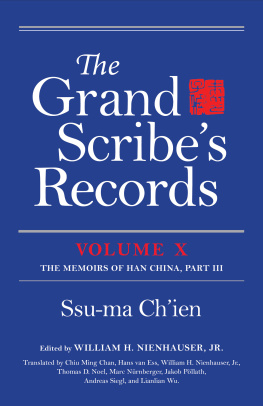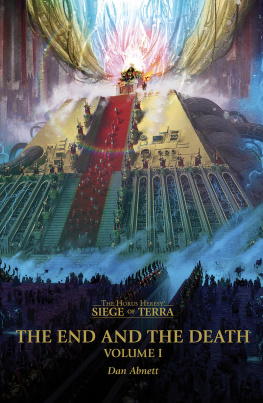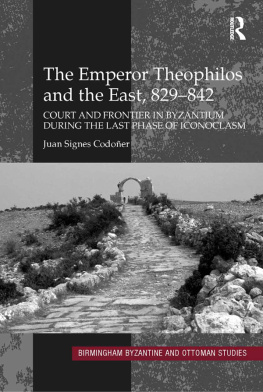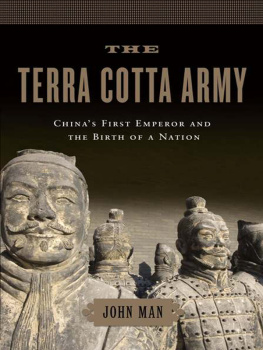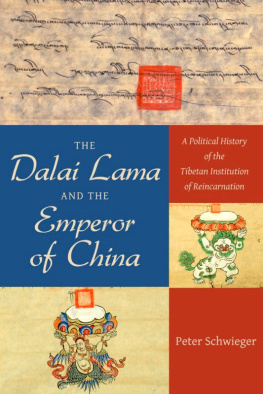
The Grand Scribes Records
VOLUME X
The Memoirs of Han China, Part III
The Grand Scribes Records
VOLUME X
The Memoirs of Han China, Part III
by Ssu-ma Chien
William H. Nienhauser, Jr.
Editor
Chiu Ming Chan, Hans van Ess, William H. Nienhauser, Jr., Thomas D. Noel, Marc Nrnberger, Jakob Pllath, Andreas Siegl, and Lianlian Wu
Translators
INDIANA UNIVERSITY PRESS
NANJING UNIVERSITY PRESS
This book is a copublication of
Indiana University Press
Office of Scholarly Publishing
Herman B Wells Library 350
1320 East 10th Street
Bloomington, Indiana 47405 USA
iupress.indiana.edu
and
Nanjing University Press
22 Hankou Road
Nanjing, Jiangsu, China
2016 by William H. Nienhauser, Jr.
2020 by William H. Nienhauser, Jr.
All rights reserved
No part of this book may be reproduced or utilized in any form or by any means, electronic or mechanical, including photocopying and recording, or by any information storage and retrieval system, without permission in writing from the publisher. The paper used in this publication meets the minimum requirements of the American National Standard for Information Sciences Permanence of Paper for Printed Library Materials, ANSI Z39.48-1992.
Manufactured in the United States of America
Originally cataloged by the Library of Congress (and revised for volume 7 [1994]) as
Ssu-ma Chien, ca. 145ca. 86 B.C.
The grand scribes records.
Includes bibliographical references and index.
Contents: v. 1. The basic annals of pre-Han China v. 2. The basic annals of Han China v. 7. The memoirs of pre-Han China.
1. ChinaHistoryTo 221 B.C. 2. ChinaHistoryChin dynasty, 221207 B.C. 3. ChinaHistoryHan dynasty 202 B.C.-220 A.D.
I. Nienhauser, William H. II. Cheng, Tsai Fa. III. Title.
DS741.3.S6813 1994
931dc20094-18408
ISBN 0-253-34021-7 (v. 1)
ISBN 0-253-34027-6 (v. 7)
ISBN 978-0-253-01931-8 (hdbk.)
ISBN 978-0-253-02069-7 (web PDF)
1 2 3 4 5 25 24 23 22 21 20
DEDICATED TO THREE OF MY FIRST TEACHERS
Lillian Stolle Nienhauser,
Julie Harding Brown,
and Nancy Brown Nienhauser
CONTENTS
(Lu Zongli)
(William H. Nienhauser, Jr., transl.)
(William H. Nienhauser, Jr. transl.)
(Chao Ming Chan and Nienhauser, transl.)
(Thomas D. Noel and Lianlian Wu, transl.)
(Hans van Ess, transl.)
(Marc Nrnberger, transl.)
(Nienhauser, transl.)
(Jakob Pllath and Andreas Siegl, transl.)
(Nienhauser et al. transl.)
Acknowledgments
In the past nearly twenty-five years Ive been reading the Shih chi with some regularity, often with large groups of other students of the Shih chi. It has been a memorable experience which has allowed me to meet with a number of scholars with similar interests around the world. Strangely, as I read more of the text carefully, I become less sure of things. This transformation made poignant recent comments by the centarian M. H. Abrams:
The world of the prophet is a hot, intense world of total assurance that you have the humanistic truth that you know what we must do to be savedand as such, it has great contemporary appeal. In comparison with the hot world of prophecy, the world of the liberal humanist is a cool world. What we need to get our students to recognize is that the stance of the liberal humanist is a very difficult one, which takes poise and courage to maintain.
The title for our translations could have been changed to Grand Scribes Records [from Grand Scribes Records] to reflect evolving ideas about the authorship of the Shih chi. This current assumption might be best summed up by citing Hans van Ess:
I am fully aware that his father Sima Tan must have written large parts of the Shiji There are good reasons to believe that some chapters of the Shiji as we have them today go back to Sima Tan .Yet I do not believe that is it possible to divide the Shiji into one part that was written by Sima Qian and one that derives from the hand of Sima Tan I share Zhang Dakes view (Shiji yanjiu ) that the Shiji in the end was finished by Sima Qian and that, should there really have been major differences between his fathers views and his own, we cannot say very much about them for sure today For these reasons, whenever Sima Qian is mentioned he is seen as the final editor of the Shiji whose ideas we can analyze today.
The chapters in this volume have been produced and revised in various venues by a host of scholars. I am grateful to all for their effort, their knowledge, and their patience. Chapters 114 and 115 were done in Singapore during my stay at Nanyang Technical University in Spring 2011. Our reading group there consisted of Chiu Ming Chan, Jia Li, Jifen Liu, So Jeong Park, Michael Puett, Jingyi Qu, Winnie Song, and Shoucheng Yan. Chapters 113 and 116 were prepared and thoroughly discussed in the summer of 2011 in Munich. Thanks to the Alexander von Humboldt Foundation Thomas D. Noel and I were able to work at the University of Munich for two months. Han van Ess reading group was then made up of Vera Dorofeeva-Lichtmann, Maria Khayutina, Marc Nrnberger, Jakob Pllath, Andreas Siegl and Anna Stecher. Chapters 117, 118 and 120 were first presented in June 2012 in Munich and then were the focus of discussion at the Sixth International Workshop on the Shih chi held in Madison in October 2012; the participants were Zhi Chen, Hans van Ess, Bernhard Fhrer, Rania Huntington, Bruce Knickerbocker, Zongli Lu, Hans-Georg Moeller, Mark Meulenbeld, Julia Murray, Marc Nrnberger, Jakob Pllath, Michael Puett, Andreas Siegl, Jingyi Qu, Jia Li, Aaron Reich, Dewei Shen, and Yiwen Shen. Two subsequent smaller meetings on Chapter 117 were held at Hong Kong Baptist University (1718 January 2013), hosted by Zhi Chen, and at Bernhard Fhrers invitation in St. Julien de Lampon, France (1114 September 2013).
Much gratitude is also owed the Center for Advanced Study (CAS), Ludwig Maximilian University of Munich, which has supported my research in Munich the past three summers. During my tenure at CAS in June 2013 and June 2014, Chapters 115, 119 and 121 were completed and discussed by an expanded Munich Shih chi group including Maddalena Barenghi, Panlam Chuen, Sebastian Eitel, Guje Kroh, Clara Luhn, Kathrin Messing, Marc Nrnberger, Jakob Poellath, Florian Shirk, Andreas Siegl, Anna Stecher, and Katrin Weiss. All of these chapters have at one time or another been read by the ever evolving Shih chi reading group here in Madison which over the past three years has included Min An, Aaron Balivet, Yaping Cai, Yang Gu, Maria Kobzeva, Hai Liu, Lu Lu, Xiang L, Ning Luo, Nan Ma, Thomas D. Noel, Youyong Qian, Ying Qin, Dewei Shen, Yiwen Shen, Henghua Su, Chen Wu, Lianliang Wu, Yinyin Xue, Fang Yan, Hong Yan, Shuxiang You, and Xin Zou.
Following this long list of scholars who have contributed to our project, a word is needed about momentum. Over the past several years I admit to having felt that perhaps I had done all I could with the Shih chi. However, Hans van Ess has encouraged me to continue the work. His contributions to the project in recent years have been immense and inspiring. In June 2013, while walking through several rooms devoted to an exhibition of Jan Brueghel the Elder at the Alte Pinakothek in Munich, I was struck by Brueghels method of cooperating with a number of painters.van Balen both lived on Lange Nieuwstratt in Antwerp and scholars believe that some paintings were shipped back between the ateliers of these two artists and composed in several stages. This cooperation suggests the relationship between Hans van Ess and myself for nearly a decade.
Next page
